From the 1994 explosions in Durban during the Apartheid struggle to Princess Diana walking the Angolan minefield, Peter Rudden has witnessed and documented some incredible times. We know the footage; these are all moments in history that have been crucial in the way society has changed over the years, but it’s not often that we get to know the man behind the camera.
Peter Rudden takes us on his journey of his life as a cameraman in an immensely important time in history. This is quite a story so grab a cup of coffee, get comfortable and dive in…

First Experience of Cameras
I remember being ten-years-old and almost bursting with excitement at the prospect of accompanying my dad to pick up the latest batch of developed photographs from the chemist. It would be fair to say that I get equally excited today when I bring footage back from the field and view it on the computer. Nowadays of course I have a colour viewfinder, zebra stripes for exposure and peaking to help me focus, so I pretty much know what I’ve shot; but in those days on my father’s Canon rangefinder camera I had 24 shots, sometimes 36 if I was lucky, a lot of which were duds! I had to align the two images in the little white box to bring the images into focus and there was a little needle that had to be kept in the centre for correct exposure. I had no idea then that I would make my living with my eye up against a viewfinder.
At the age of 15, I also had no idea that my first holiday job operating the spotlight at the Durban City Hall would help guide me towards my eventual path. From a hot booth at the back of the hall, my thin beam found his way to Johnny Clegg as he belted out the lyrics to ‘Impi’. The music was loud, the crowd screamed and the lights were fantastic. It was then and there that I fell in love with the theatre.
After school and, of course, national service, I settled down to life as a lighting technician at the Natal Playhouse. It was great fun but didn’t pay well, so, at the age of 25, I started studying video at Tech. It was around the same time The Video Lab opened in Durban and I managed to land myself a job as a freelance camera assistant. The pay was much better than at the theatre and that, along with the hands-on experience I was gaining, lead me to drop my studies. My learning was fast-tracked and I soon went onto becoming a soundman and then having opportunities to operate the camera. There was something about looking through that black-and-white viewfinder that was magical and, despite being told by my lecturer that “I would never get a job without a piece of paper”, I went for it.
It was good timing as regional TV had commenced and MNET was fresh on the scene. I freelanced for absolutely anybody and everybody as a cameraman… news, sport, features, corporates, music videos, commercials, weddings, fashion shows; I would do anything!
In late 1993, one of my clients told me that Reuters television was looking for cameraman in Durban for the run up to the South African elections of 1994. I had to ask my father who Reuters were! Looking over his glasses, he said “It’s the biggest news agency in the world, son”.
Joining the Reuters Team
The following week I was at an appointment in central Durban when a bomb went off on the bus opposite the City Hall. In those days the international television standard was Betacam and there weren’t too many of those cameras floating around, but it just happened that one of my clients was one block away. I raced to him, loaned his camera and hurried down to the bombed bus scene. Filled with adrenaline, I filmed the scene and ran into the City Hall to use the phone belonging to an old boss. I called Reuters TV in Johannesburg and told the senior producer there had been a bomb on a bus in Durban. “How long will it take you to get a camera and rush down there?” he asked. “I have already filmed it on a Betacam” I replied. “The tape is in my hand. What do I do with it?”
So began a five-and-a-half year stint with Reuters television. News agency work is very competitive and at that time South Africa was one of the hottest news stories in the world. I was thrust into the deep-end covering the political violence that took place in the hills of KZN. It was exciting, it was dangerous, it was history in the making, and I was there to film it knowing millions of people around the world would watch my footage. Sitting eating a hotel breakfast and seeing the top story on the BBC running my pictures was the most amazing feeling. After the elections, they made me staff and I moved to Johannesburg. And so the traveling began. Bosnia, Mozambique, DRC, Angola, Sierra Leonne, Congo, Liberia; big news stories, fast turnarounds and having to learn to edit tape-to-tape. It was a fantastic time filming presidents, rock stars, famous actors and sports stars.
Walking the Minefield with Lady Diana
It was on a trip to Angola in 1997 that I shot my most watched piece of video. I was the ‘pool’ cameraman for Lady Diana’s walk into the minefield. For those who don’t know, a pool cameraman is the one chosen to film for all the agencies in situations where it is not possible to have, say, 20 cameras going in together. So, the shots of Diana in the minefield wearing blue body armour and glass facemask were mine! It wasn’t an easy shoot as I too had a facemask, meaning I couldn’t get my eye to the viewfinder. The millions who have watched those shots don’t know it was me that filmed them, but I do, and that’s satisfying enough for me.
I got sidetracked from 1998 to 2001 when I learned to be a satellite uplink engineer operating satellite trucks and mobile satellite uplinks for big international events: Olympics in Athens, World Cup cricket, World Economic Forums, the land invasions of Zimbabwe, and stuff like that. But after September 11, 2001, all that changed. My old Reuters boss wanted me to go as a cameraman/editor into Afghanistan where I would be embedded with the Taliban. A reporter for ETV had a connection to the Taliban who said that if we went with him to Pakistan he would get us in.
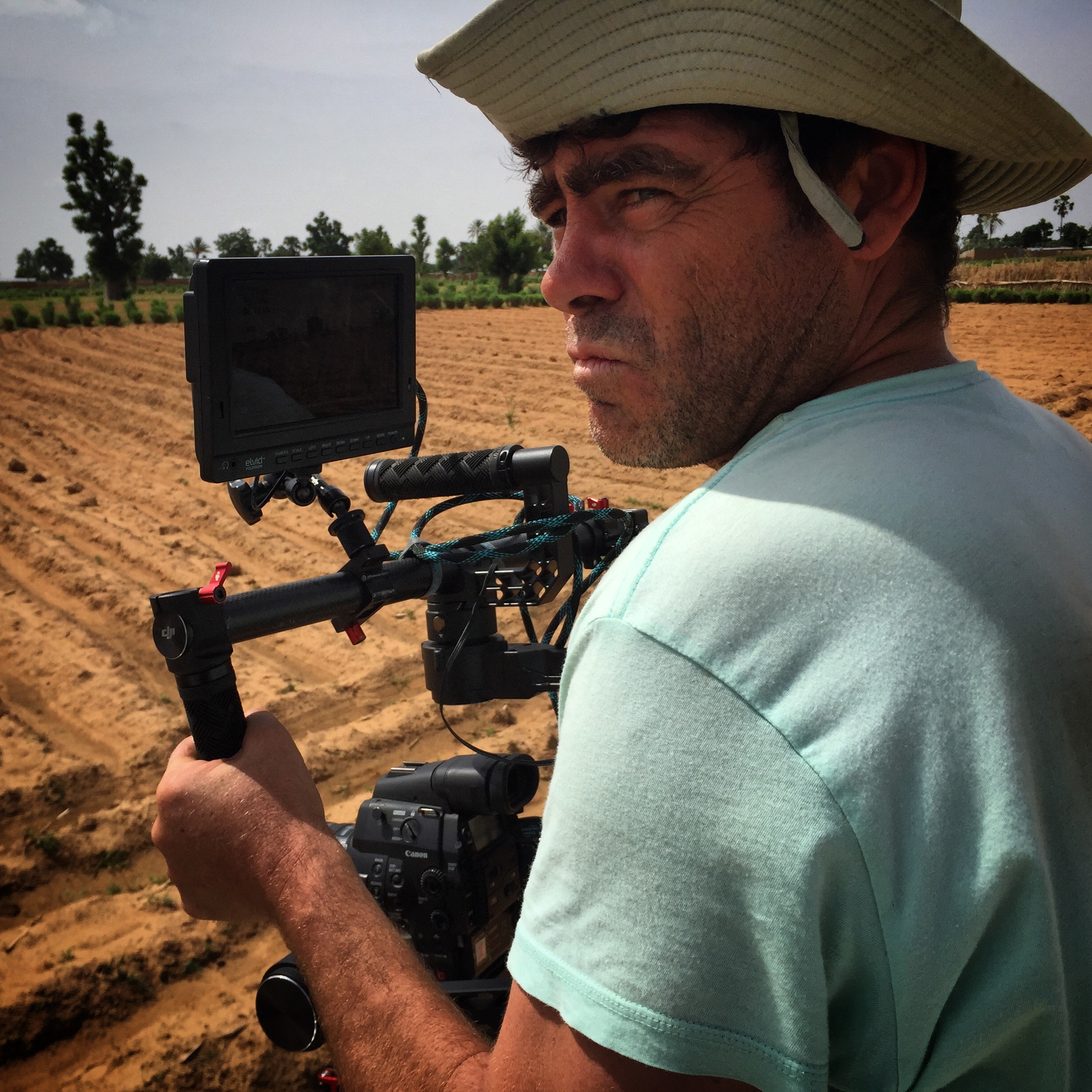
Spending a Week with the Taliban
Following 9/11, the world’s media had descended on Pakistan to report on the US-led war that had kicked off and most of the foreign correspondents in Kabul had been sent away, thus the huge media presence in Pakistan next door. So, with a hand-written note in Arabic, Faizel Cook and myself were driven over the Khyber Pass in an old Toyota and dropped off – much to the surprise of the guards at the Afghanistan border. We schlepped all our gear into a guard hut on the Afgan side that was filled to the brim with rocket launchers and AK47s. As we entered, note in hand, the call to prayer sounded and I looked at Faizel and said: “ I hope you know what to do!”
We spent a very interesting week with the Taliban who took us to bombed out schools and villages and to meet wounded people in hospitals. We did a bit of running from bombs dropped by warplanes, and both got a severe dose of the runs. We were the only guests at the Spinghar Hotel in Jalalabad where we made nightly video diaries and tried to sleep while our windows rattled from nearby explosions.
After the Taliban were defeated I was one of the first waves of foreign media who flocked to the Inter-Continental hotel in Kabul. I was now working for Reuters as a freelance satellite engineer and we had five rooms, only one of which had water, and two had glass instead of plastic as windows. It was mid-winter and there was snow on the ground. The Taliban had been defeated and the mood on the street was joyous. Many years followed with me working mainly as a satellite engineer and doing a bit of shooting here and there.
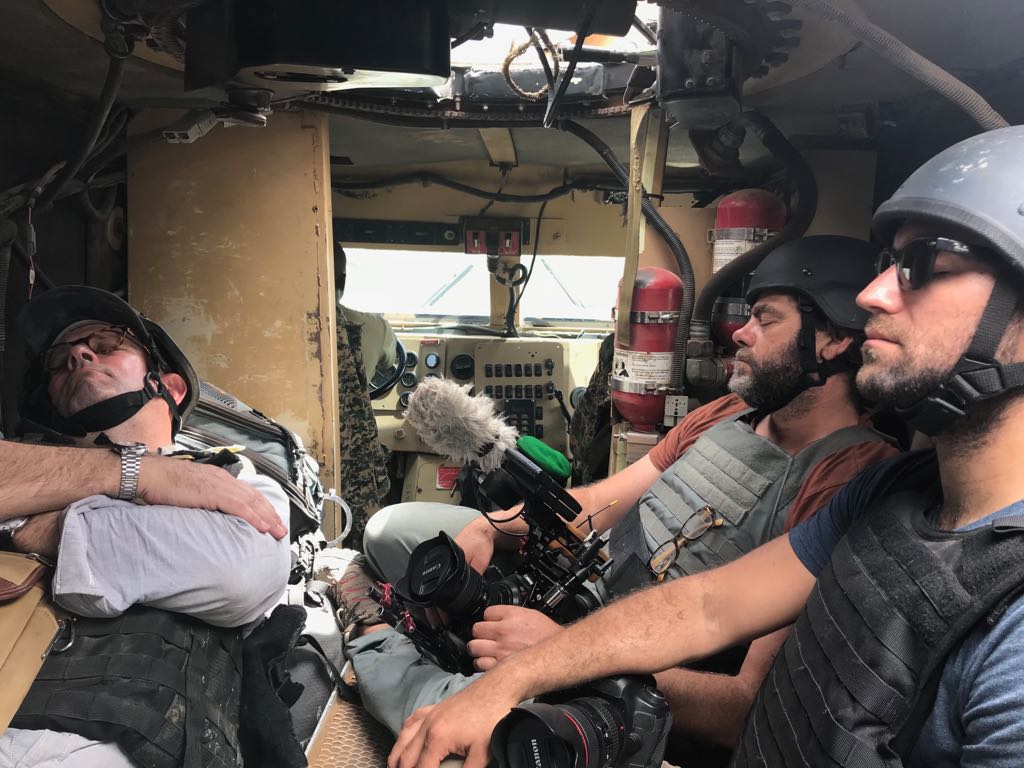
The Gulf War II
Then came the Gulf War II, during which time I hooked up with the American Broadcasting Company. Four days after the Sadam statue hit the ground we drove a convoy of cars from Amman in Jordan to set up the broadcasting base for ABC at the Sheraton Hotel. I got recruited by another American network and soon enough I was offered a high profile embed as a cameraman with an American armored battalion. It would be the first of many embeds in Iraq over the next seven years. It would also prove the most dangerous as I was in the thick of street-to-street combat with casualties on both sides. The sound of war is so very loud. I picked it up really quickly. Big loud bangs and gunfire were probably coming from the troops and military vehicles around me, but the not-so-loud whistling and then getting-louder-faster sounds where bullets coming my way. And then there were the rocket-propelled grenades, which were a firm favorite of the insurgents. One landed close to me and resulted in a piece of shrapnel lacerating my hand. It could have been worse… I was lucky.
One night, quite by accident, I found myself with a group of Special Forces soldiers who were going into a Mosque that had been the base that an attack was launched from. They don’t enter through doorways as they are scared of booby traps, so they blow a hole in the wall. I clearly remember the command “fire in the hole”. They took me in with them and showed me the weapons stashed inside and the door, which, it turned out, had explosives rigged to it.
On the first night out with the troops, I didn’t have the correct infrared identification strapped to my helmet. I was with the commander of the raid and the combat had died down a bit but there was a tank 50 meters away that looked like it was positioning itself to fire. I had been told by the commander’s second-in-charge not to move away from the Bradley fighting vehicle… but I couldn’t resist and headed out alone to get closer to the tank. I got the shot I was after and ran back to the commander’s vehicle. I was shocked to learn that the helicopter flying above had spotted someone running who was not wearing the infrared identification worn by American soldiers. The pilot had radioed down to the commander for permission to “take him (me) out”; a spine-chilling reality check.
The highlights of my many years in Iraq was seeing the hidey-hole where Sadam Hussien was captured, and traveling in 11 different types of helicopters, including a cool thing called an Osprey that takes off as a helicopter and then turns into a plane midair.
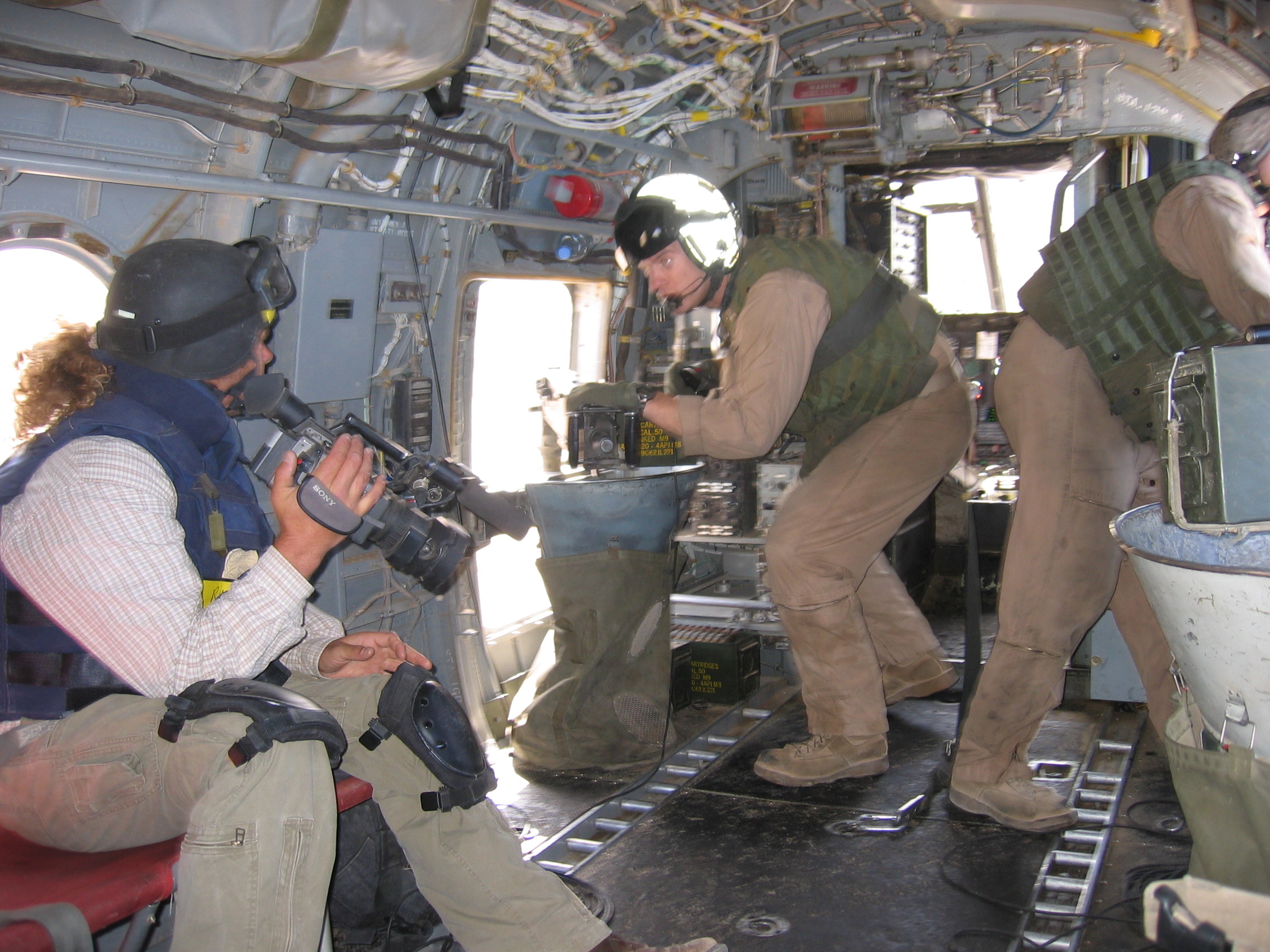
The job can sound very exciting and glamourous but, truth be told, most of my trips were just dusty and hot. Schlepping gear from one base to another, sleeping in dorms with soldiers and flying from place to place at midnight is not much fun. As a civilian, to be dropped into that kind of environment is very strange indeed. It really is like the movies… or the movies are like it. But in the movies, people die instantly when they are shot, and in real life it’s not really like that.
It was very disturbing to me to see the destruction that can wreak the human body. I managed to cope with it by looking through the camera. That would take me away, somehow. I justified it to myself by thinking that I did not create or add to the situation. It really had nothing to do with me; I was just witnessing it and recording the scenes that make history.
In those days the camera of choice was a Sony PD 50, a small cheap tool that was good for those types of environments. Back at base, the mini DV tapes could be ingested in real time onto a computer for editing and transmission. A correspondent I worked with often traveled with his own company supplied gear and he insisted on two of everything. Although it was a mission to double up I was saved on a few occasions when gear went down and there was a replacement right there. Traveling with redundancy is something I still do to this day.
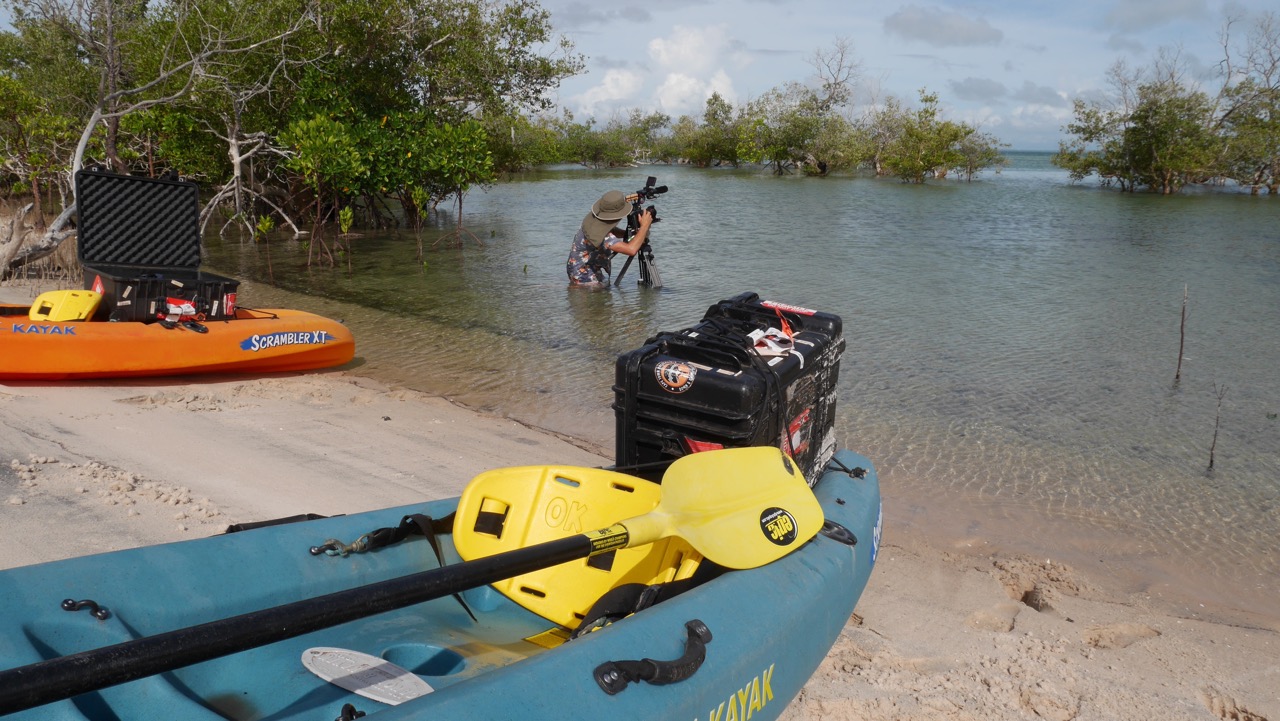
Working with CNN
A chance encounter at the business class lounge in Johannesburg led to the most recent chapter in my journey. My soundman from my Reuters days had progressed on to be the South African CNN staff cameraman. He and his bureau chief were on their way somewhere and asked me if I would like to do some work for them. CNN has many departments other than news, including a few African feature shows that run weekly. I was keen to get involved and soon enough I was zooming all over Africa on various assignments. Of course, by now the technology had moved on from recording on tape to camera cards that could be slotted into the computer for speedy ingestion. HD was the new buzzword and one of the cameras that CNN used was the Sony EX3.
But, even though I worked as a cameraman, I was still passionate about photography. So, I decided it was time to invest in a Canon 10 DI and some quality Canon L series lenses. I had great fun taking some beautiful stills and really enjoyed the quality the lenses afforded. A few years down the line I heard talk of the Canon 5D mark II. The hype was tremendous and piquied my curisotuy. Apparently, you could now shoot video on a still camera. I dismissed it initially. But a friend from the States had acquired one and found it too big for his needs so he offered it to me at a super cheap price, and I couldn’t resist. I still remember being absolutely blown away when I turned it to video mode… depth of field, HELLO! As I already had loads of glass I bought a few add-ons – a Zacuto viewfinder, a Zoom portable recording device and a few microphones – to turn it into a video-making tool.
The next time a CNN correspondent came to Cape Town I set up the EX3 and the 5D next to each other and shot the same size frame of her piece to camera. I laid the two shots back-to-back on a timeline – Ex3 first then 5D – and went to the Bureau chief in Johannesburg for him to see for himself. From that day on the EX3 stayed in the bureau and my 5D mark II took center stage. Luckily for me, Orms is just down the road from my house. I acquired a Canon 7D along with some more lenses, batteries and cards to do two-camera shoots. My set up is 5D with a wide lens and 7D with my long lens. Shooting news and features ‘run and gun’ style with these cameras is not easy. The focus is critical, the sound has to be captured separately and synced later, and there is a lot of lens changing going down. But it is all worth it every time. The picture quality is superb.
On a trip to Orms, I noticed a new section called Pro Broadcast headed up by Juanne from Visual Impact. He told me about the newest Canon offering the C 300. I was sold instantly and bought two. That was over five years ago and they are still going strong. Even now when I look at post-shoot images on my Mac I am impressed with the results. Most of my lenses are 15 years old!
It has been 10 years already that I’ve been a permalancer for CNN. Mostly on the African continent doing work for their different departments: features, news, sport, special events and breaking news. The benefits of my cameras have come to the fore so many times when having to shoot in tight spaces and low light situations. I am able to sync the time codes for easy editing and I’ve have done hundreds of live transmissions through their SDi out connection. With the technology nowadays, I am able to go live and playback camera cards with a small belt pack device utilizing the GSM network.
The Zimbabwe Coupe
There have been many highlights during this decade but the one that stands out the most was getting a call at 4 AM from the senior producer telling me there had been a coupe in Zimbabwe. In order for me to make the connection to an early flight from Johannesburg I had to get the first flight out of Cape Town. (Aside from the fact that we didn’t have press accreditation, so we’d have to enter the country as tourists.) In the early hours of that morning I had to pack my gear fast, leaving behind obvious things like tripods. I did away with my flight cases and threw things randomly into a suitcase. I made it to Johannesburg and then on to Harare, where I knew the ever-vigilant customs guys were waiting to pounce. My camera bodies were in my backpack and lenses and sound gear were in my case. Of course, they pulled me aside anyway and their eyes lit up when they saw all the gear in my bag. But somehow I managed to convince then that I took photos for a hobby and used the sound gear to record the sound of the animals… and the stripped-down C 300s were just my fancy stills cameras. My colleagues also managed to sneak their transmission equipment in. Using a stepladder for a tripod, CNN was the first network to start reporting live from Zimbabwe.
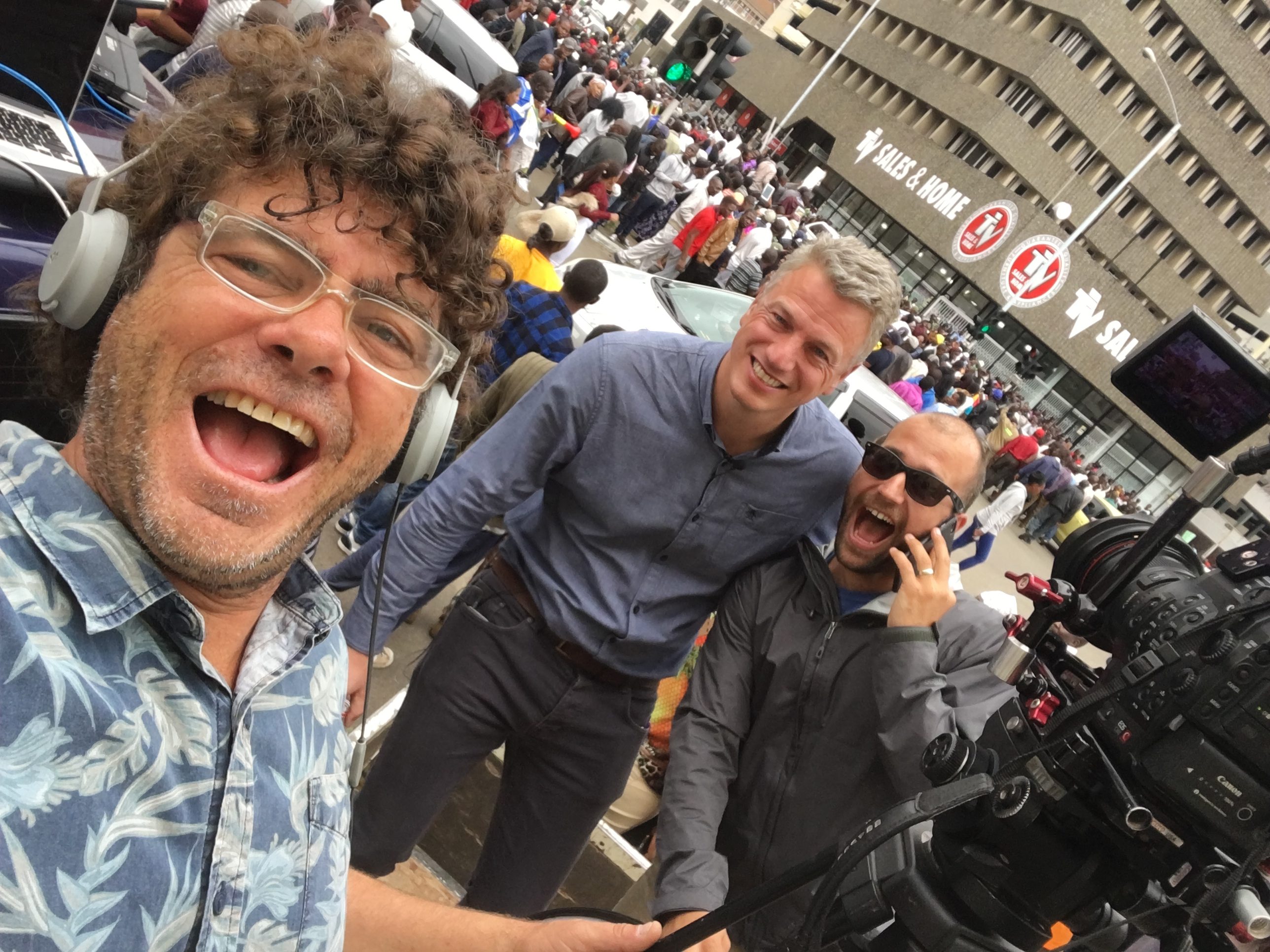
A few days alter Mugabe finally resigned and producer Brent Swails, correspondent David McKenzie and I were in the central park opposite parliament. On hearing the news we fired up our transmitter and made contact with the control room in Atlanta. CNN International broke into programming with the breaking news and for the next twenty minutes received my shot as we weaved through the growing crowd who flooded the streets to celebrate the end of a dictator. It was a fantastic time for the people of Zimbabwe and for our team witnessing history being made.
Some of the other highlights of the last decade have been filming the mountain gorillas of Virunga National Park, capturing the Maha Shivaratree festival in Mauritius, trekking through the Congo rainforest with rangers, spending time with the Baka tribe in Cameroon, exploring the streets of Havana Cuba, the Rio carnival and filming the Komodo Dragon on Komodo Island.
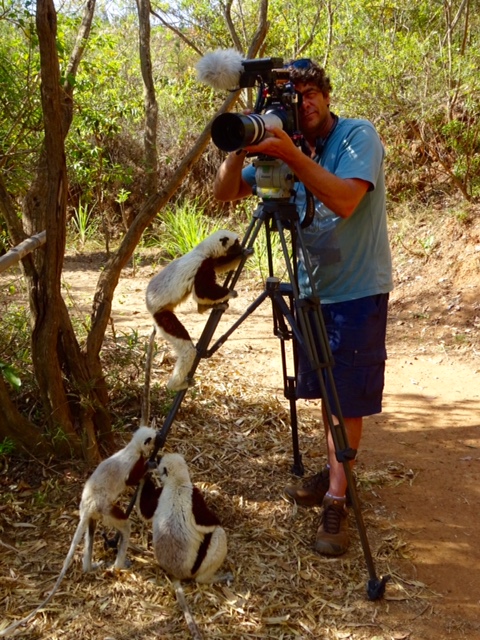
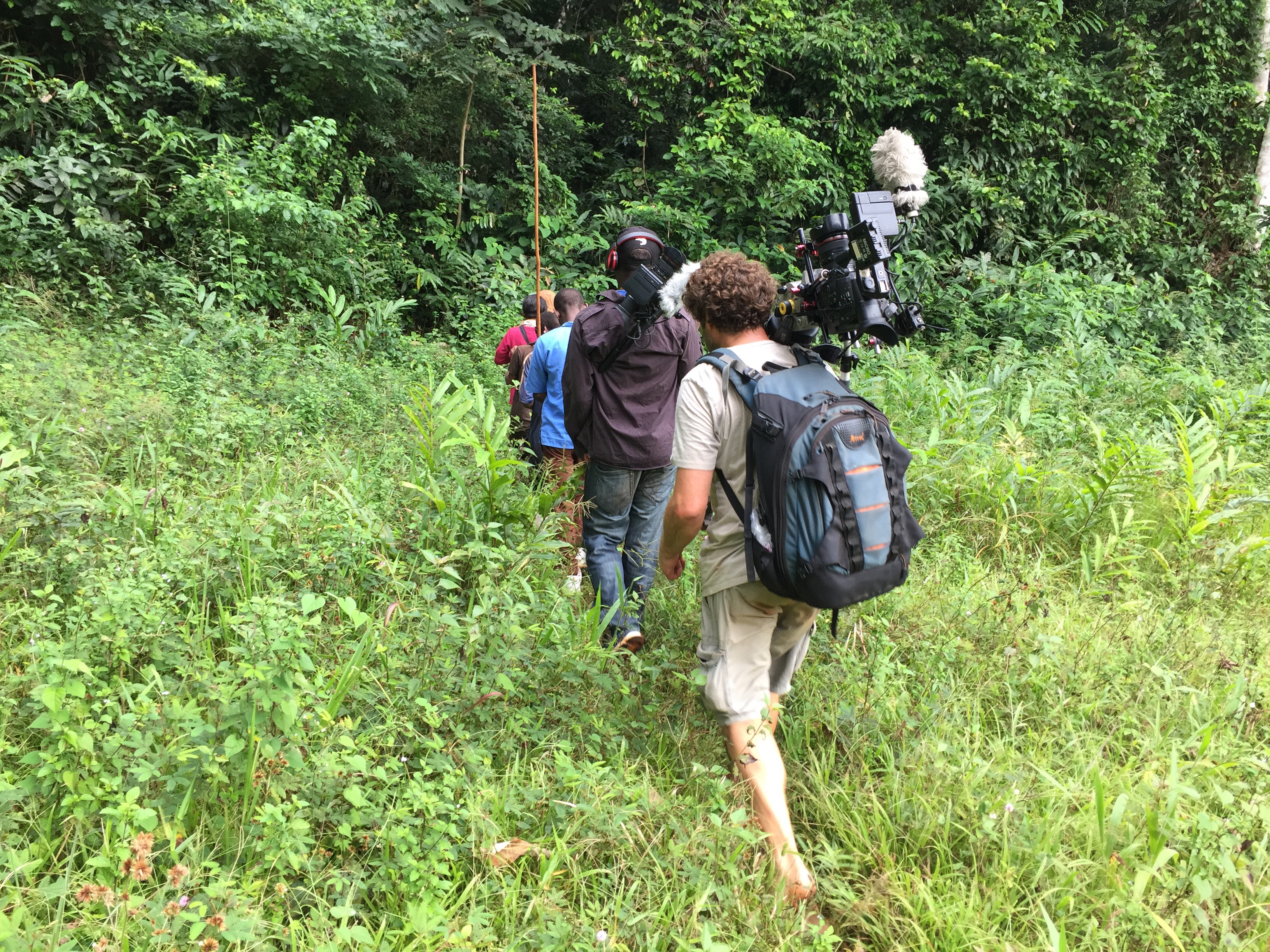
To date, I have worked in 52 countries around the world and spent time with the most interesting and amazing people imaginable. I’ve witnessed incredible events and although the pressure is sometimes intense, I’ve loved every second. Every day filming is spent in a different place. There is no script, no storyboard, no rehearsals or second takes. I really do feel blessed in saying that I feel I have the best job in the world.








Very impressive, quite a list of achievements to be proud of.
Stay safe.
Regards